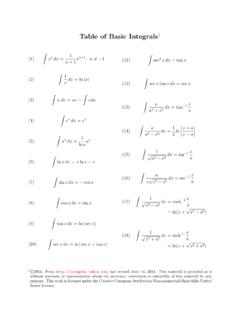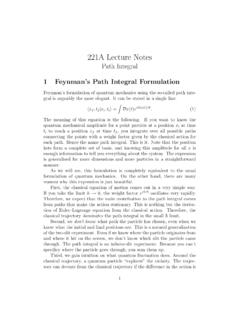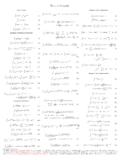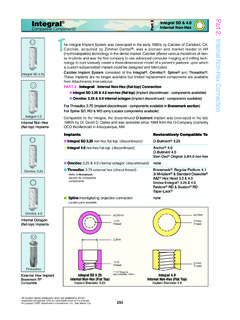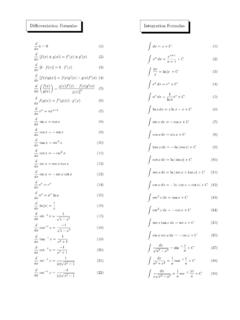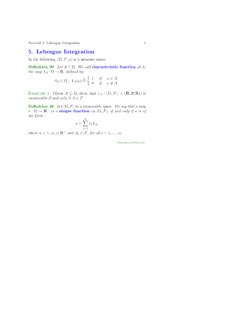Transcription of MT5802 - Integral equations Introduction - St Andrews
1 MT5802 - Integral equationsIntroductionIntegral equations occur in a variety of applications, often being obtained from adifferential equation. The reason for doing this is that it may make solution of theproblem easier or, sometimes, enable us to prove fundamental results on the existenceand uniqueness of the the unknown function by we consider linear Integral equations which involvean Integral of the form K(x,s) (s)ds or K(x,s) (s)ds ax ab The type with integration over a fixed interval is called a Fredholm equation, while if theupper limit is x, a variable, it is a Volterra other fundamental division of these equations is into first and second kinds. ForFredholm equation these are f(x)=K(x,s) (s)dsab (x)=f(x)+ K(x,s) (s)dsab The corresponding Volterra equations have the upper limit b replaced with x.
2 Thenumerical parameter is introduced in front of the Integral for reasons that will becomeapparent in due course. We shall mainly deal with equations of the second solutionsOne fairly obvious thing to try for the equations of the second kind is to make anexpansion in and hope that, at least for small enough values, this might converge. Toillustrate the method let us begin with a simple Volterra equation, (x)=x+ (s)ds0x .For small , 0(x)=xis a first approximation. Insert this in the Integral term to get abetter approximation 1(x)=x+ sds0x =x+12 put this into the Integral to get 2(x)=x+s+12 s2 0x ds=x+12 x2+16 this process, we get n(x)=x+12 x2+..+1n! n 1xnand, as we let n , the series converges to 1 e x 1(). Substituting into the equationverifies that this is the correct solution.
3 So, for this Volterra equation the technique ofexpansion in series gives a result which is convergent for all .We now show that this works for all Volterra equations , subject to some fairly generalconditions. Suppose that we look for a solution with xin some finite interval [a,b]andthat on this interval f(x)is bounded with f(x)<m. We also suppose that, on theinterval [a,b] [a,b], K(x,s)< 0(x)=f(x)<m 1(x)=f(x)+ K(x,s)f(s)dsax <m+ mMx a() 2(x)=f(x)+K(x,s) 1(x)ax <m+M(m+mM(s a)ax )ds=m1+ M(x a)+12 2M2(x a)2 Carrying on like this we get n(x)<m1+ M(x a)+12 2M2(x a)2+..+1n! nMn(x a)n Since the series here is of exponential type we get convergence for all values of . Now see whether the same thing works for Fredholm equations . Again we look at anexample - (x)=x+ (s)ds01 similar to the previous one, except for the fixed range of we get 0(x)=x 1(x)=x+ sds=x+1201 2(x)=x+ s+12 01 ds=x+12 +12 2and, continuing in this way n(x)=x+12 + 2+.
4 + n().Now we get a geometric series which only converges if <1. In this simple problemthe series can be summed and letting n we get the solution (x)=x+ 21 ().Since we have managed to sum the series, we get a solution valid for all 1. In moregeneral problems, the series will not be easily summable and will only be valid for arestricted range of values of .The series obtained in this way, for either type of equation is known as the : Find the first two terms of the Neumann series for the equation (x)=sinx+ cos(x2s) (s)ds0 /2 .We get 0(x)=sinx 1(x)=sinx+ cos(x2s)sinsds0 /2 =sinx+ 2sin((1+x2)s()+sin((1 x2)s)ds0 /2 =sinx+ 2cos((1+x2) 2) 11+x2+cos((1 x2) 2) 11 x2 Separable kernelsSuppose the kernel of a Fredholm equation is a product of a function of x and a functionof s, to the equation is of the form (x)=f(x)+ u(x)ab v(s) (s)dsClearly the u(x)can come outside the Integral and if we write c=v(s) (s)dsab then we have (x)=f(x)+ cu(x).)
5 All we need to find is the constant c and this can be done by multiplying the last equationby v(x)and integrating from a to b. This gives c=f(x)v(x)dx+ cu(x)v(x)dxab ab so c=v(x)f(x)dxab 1 u(x)v(x)dxab .This leads to the solution, so long as the value of is not such as to make thedenominator : Solve (x)=x2+ x3s2 (s) The solution is (x)=x2+ x3cwith c=s201 (s) the last two equations we get c=x401 dx+ cx501 dx=15+16 , unless =6we have (x)=x2+15x36 6 .The value of for which the solution breaks down is an eigenvalue of the , go back to the general form of the equation and look what happens at this the homogeneous equation corresponding to our original equation by (x)= u(x)v(s) (s)dsab (ie put f=0). Multiplying this by v(x)and integrating gives v(x) (x)dx= u(x)v(x)dxv(s) (s)dsab ab ab which implies that v(x)u(x)dx=1ab.
6 There can be no solution of the homogeneous equation unless this condition is it is satisfied then it is easily verified that (x)=ku(x)is a solution for arbitrary back to the inhomogeneous equation, it can be seen that if is equal to theeigenvalue, and a solution exists, then the condition v(x)f(x)dx=0ab must be satisfied. Thus the solution can only exist for certain functions f. If such asolution exists then any multiple of the solution of the homogeneous equation can beadded to it. To summarise, we have,(a) eigenvalue - unique solution exists, or(b) =eigenvalue - solution may or may not exist and if it does it is not equation has a solution, any multiple of which can be are clear parallels between this and the matrix equation X=F+ AXwhere X and F are column vectors and A a matrix.
7 This is a discrete analogue of theFredholm equation. This has unique solution X=(I A) 1 Xif the inverse exists, which it does except for certain values of (the inverses of thematrix eigenvalues). At these values of the homogeneous equation (F=0) has a non-trivial solution while the inhomogeneous equation may or may not have a solution, and ifit does arbitrary multiples of the solution of the homogeneous equation can be added to KernelsThe method outlined above can be extended to the situation where K(x,y)=ui(x)vi(y)i over some finite range of i. To see this we look at an example - (x)=x+ (xy+x2y2) (y)dy01 .If we let c1=y (y)01 c2=y2 (y)01 then the solution is (x)=x+ (c1x+c2x2).If we multiply this by x then by x2 and integrate from 0 to 1 in each case we obtain c1=13+ (13c1+14c2)c2=14+ (14c1+15c2)or 1 13 14 14 1 15 c1c2 =1415 This gives c1c2 =1240 128 + 2 48( 5)60 60 80( 3) 1/31/4 and hence a uniquely defined solution unless 2 128 +240=0ie =64 two values are the eigenvalues for this problem.
8 If takes one of these valuesthen the equation 1 13 14 14 1 15 c1c2 =00 has a non-trivial solution. This gives a non-trivial solution to the homogeneous integralequation (which may be multiplied by an arbitrary constant).If we consider a kernel of the general form K(x,y)=ui(x)vi(y)i=1n then we can follow the same procedure and will end up with an n n matrix to determinant will be an nth degree polynomial in with n solutions (possiblycomplex and possibly repeated) which are the eigenvalues. If is not an eigenvalue thenthe matrix can be inverted and a unique solution found. If it is an eigenvalue then thehomogeneous equation has a non-trivial solution. In this case, the original equation mayor may not have a solution. To obtain the condition under which a solution exists weintroduce the transposed equation (x)=f(x)+K(y,x) (y)dyab where the arguments in K are swapped over.
9 This produces a matrix which is thetranspose of the original and has the same eigenvalues. If (x)is a solution of thehomogeneous transposed equation for the eigenvalue then if we multiply the orginalequation by (x)and integrate from a to b we get (x) (x)= (x)f(x)+ K(x,y) (x) (y)dxdyab ab ab ab .From the definition of (x)it satisfies (x)= K(t,x) (t)dtab from which it can be seen that the x Integral in the last term above just gives (y) and thewhole term is (y) (y)dyab which, of course, just cancels the left hand side. So, we conclude that if a solution existswe must have (x)f(x)=0ab .Example: Solve (x)=sin(x)+ cos(x y) (y)dy0 /2 .The first thing to note is that using the formula for cos(x y) brings this into the formwe want, namely (x)=sinx+ (cosxcosy+sinxsiny0 /2 ) (y) c1=cos(x) (x)0 /2 dxc2=sin(x) (x)0 /2 dxwe get c1=12+ c1 4+c212 c2= 4+ c112+c2 4 or 1 4 12 12 1 4 c1c2 =12 4.
10 The matrix here can be inverted unless =1 4 12, the result being c1c2 =816 8 + 2 2 4 24 +4 + 216 8 + 2 2 4 2 .Looking at what happens at the eigenvalues, with the + sign we get c1=c2if we put theright hand side equal to zero, giving the solution cosx+sinx(or any multiple of this) forthe homogeneous equation. This is also the solution of the homogeneous transposedequation (which is the same as the original). For our equation to have a solution for thiseigenvalue we need sinxsinx+cosx 0 /2 =0which is not true, so no solution exists. This can also be seen from the above matrixequation, the two equations being incompatible if has this value. The condition for theexistence of a solution with the inhomogeneous term replaced with a general function f(x)is f(x)cosx+sinx 0 /2 = can be seen that what this does is ensure that the vector on the right hand side of thematrix equation is such as to be compatible with the left hand side, the two equations thenbeing identical.
